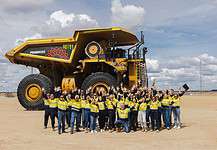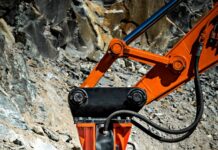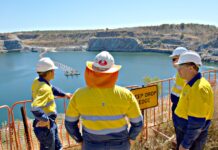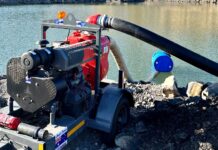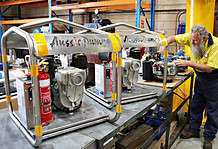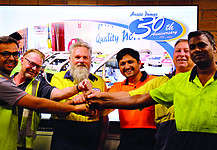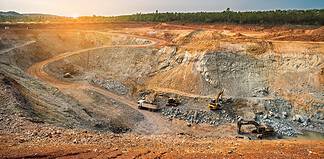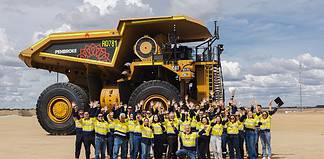PARTICLES of Inconel or tungsten carbide heated to 3000ºC in a jet-fuelled flame, boosted by liquid oxygen and colliding with a steel shaft at Mach 3 – welcome to the world of HVOF.
The Australian Mining Review visited High Velocity Technologies (HVT) in Maddington, WA, for an insight into this high-tech, high-temp process.
High Velocity Oxygen Fuel (HVOF) is a unique process that allows a metal substrate to be built up or coated with range of anti-corrosive or extremely wear resistant metal particles.
These particles are heated to the point of plasticity as they are introduced into a flame path created by burning A1 jet fuel with liquid oxygen added as an oxidiser to create a 2000ºC super-sonic torch.
As the highly malleable particles of tungsten carbide, Inconel, chromium carbide, cobalt chrome or chromium-nickel-boron move towards the metal substrate, they are shrouded with a nitrogen carrier gas, which is coaxially injected at the hand-piece.
The relatively ‘low’ temperature at which HVOF is applied is advantageous as it is comparatively ‘cold’ compared to other metal coating techniques, resulting in less change to metallurgy of the metal substrate.
The end result of this molten metal bombardment is super-hard surface that is less than 1pc porous and can be finish ground to an incredibly smooth finish of only 0.05µm RA if required.
The surface finishes available provide optimal conditions required for seals, and the HVOF process is widely used to reclaim hydraulic shafts and other areas that experience wear, abrasion or friction – especially under the rigours of mining operations.
HVOF is the next step up from hard chrome, which certainly has its applications, but when it comes to high temperature applications, extreme loads or highly acidic or alkaline environments, the correct metal coating applied with HVOF will provide greater protection of the work surface and many times the working life of hard chrome.
In the mining world, the longer a machine is in operation, the more money it can generate.
Downtime is the enemy of any operation striving to maximise productivity and profitability for its shareholders and that is exactly why HVOF coating technology is used so widely in the industry.
Applications aplenty
The list of uses for the various metal coatings that can be applied using this technique are almost limitless but one prime example is increasing the corrosion resistance of downhole and digging tools – particularly those used in acid sulphate soils.
Ground Engagement Tools (GET) and wear plate can be coated with up to 5mm of tungsten cCarbide to provide surface hardness of 9Mohs (file steel is 7Mohs and diamond is 10Mohs) and dramatically extend the life of these hard-working tools.
HVOF coatings are creating significant cost savings and increased production when applied to the front and rear suspensions and hydraulic braking systems of automated dump trucks.
By the nature of their automated control systems, these trucks do not deviate to avoid rocks or pot holes in the haul road and they typically carry heavier loads and travel faster than their manned counterparts.
While the extra wear and tear does increase operating costs, the extra payload delivered each shift offsets these costs significantly.
Some mining contractors report that converting to fully automated trucks has increased haul truck operating costs by about 1pc but has also increased delivery of ore by between 10-15pc – so the extra expense is far outweighed by the extra revenue derived.
HVOF coatings contribute to each truck having longer service intervals, less component wear and failure and ultimately less downtime. So, each truck becomes more profitable to the operation in real terms.
Those in the drilling game will be familiar with a Hydra-jar – a double-acting hydraulic drilling jar, which amplifies force at the surface to free stuck or jammed drillstring components.
A Hydra-jar is capable of delivering up to 1,000,000-pounds (?4.5MN) of force to the drill head – enough to tear the hardened surface of the drill head itself.
HVT regularly coats the Hydra-jar assembly components with an HVOF covering to protect them from such brutal forces and the extremely degrading effects of such a corrosive environment.
A specific powder matrix is applied to such components to provide incredible corrosion resistance, reclaim parent material lost to wear and effectively hard-face the components to withstand not only regular abrasive wear, but also the shock loads imparted by the Hydra-jar when it is applied.
Other applications for HVOF include ash fans, train exhaust fans and heat exchangers.
Power stations also benefit from the technology. They use large valves with bearing plates to regulate the airflow to the furnaces and these plates are subjected to concentrated heat and super-sonic air vortices containing particulates that burn through the plate after a relatively short time.
HVT has coated many of these plates using specific HVOF alloys and the valves are rated for 10-years without failure – a true indication of quality and resilience.
Cast iron welding and repair
Formerly known as United Welders, HVT is the continuation of more than 70 years of a multigenerational welding legacy renowned in WA.
Offering exceptional specialised TIG, MIG and manual arc welding services, HVT also has a long history of proven success with cast iron welding and other exotic materials.
Recently, HVT was tasked with the development and execution of the complex repair of splines on a 793 extended-life rear brake housing, as a result of a worldwide component shortage.
As a critical component of the vehicle, there is no established repair procedure from the OEM.
After a series of qualitative and quantitative material tests, HVT established a repair process and ‘forged’ ahead.
About 30pc of the splines were cracked 10-15mm down their length.
Firstly, these damaged sections were removed from the housing.
The casting was then encapsulated in a forge and pre-heated to several hundred degrees in preparation for welding.
While holding the casting at temperature for the duration of the welding process, the damaged splines were rebuilt around the diameter of the housing.
After slow-cooling, the splines were worked back to OEM specifications and non-destructive testing was undertaken to confirm the housing was devoid of cracks.
Successful identification of cast iron structure/type is critical to these repairs, as pre- and post-heat treatment processes and temperatures, interpass temperatures, choice of welding process and electrode/wire selection is paramount in achieving the desired yield and tensile strength.
It also avoids problems with porosity and heat-affected zones, and the subsequent formation of undesirable structures.
Heat-affected zones can cause formations of brittle structures such as martensite and cementite, which put the component at high risk of post-weld cracking due to lowering of tensile strength. Different methodologies applied throughout the process can affect the outcome. For example, post-weld annealing can lower the hardness of martensite that may form in heat-affected zones, but post-weld heat treatment will not restore full ductility and toughness to something like nodular cast iron due to the formation of secondary graphite.
Warped, dropped and holy
In-line with its affinity for complex repairs, HVT was the recipient of an R1300’s cast iron converter case, which had already been subjected to a failed weld attempt at another service provider.
Unfortunately, an already significant hole in the housing was made worse by heat-affected zones in the surrounding area forming brittle structures and resulting in further cracking of the housing.
To make matters worse, the housing was exceptionally warped – 6mm out of round and dropped by 3mm.
Simply welding a piece of plate into the gap would not be enough to make the case serviceable again.
To counteract the warped housing, bracing was designed and manufactured to re-align it with the flange faces/PCD and to support the housing throughout the welding process.
A piece of plate was fused into the housing under forge conditions and at exceptionally high temperatures – so hot the welding helmets were melting and multiple helmets were used on rotation to allow them to cool.
After days of slow cooling, the housing was machined back to specifications and successfully returned to service.
Source:
High Velocity Technologies
(08) 9493 1355




